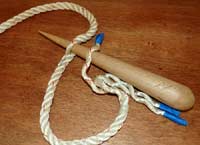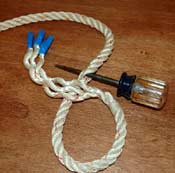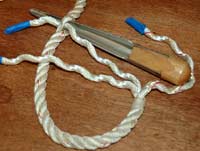| In earlier columns, I've talked about eye splices,
seizing line and marlinspike skills but I have failed
to talk about the one tool that is a must for eye
splices and general marlinspike work- the fid. Oh,
you can make an eye splice without a fid but it is
so much easier with a fid that you will always have
at least one in your marlinspike kit.
Now, if this were the 1800’s and we stood
before the Queen’s Mast or the Mast of American
ship we’d probably have at least 5 fids in our
marlinspike kit, ranging from small to large, so we
could work on a wide range of rope sizes. We would
have made them ourselves and put a Turk’s-Head
knot or some other fancy knot work on them because
there was a lot of spare time and Sailing Masters
didn’t like seeing idle hands.
 |
Figure 1 - homemade
Maple fid
(click images
to enlarge) |
However, this isn’t the 1800’s, none
of us stand before the mast, and most of us are desperately
trying to find some spare time. This, of course, is
why most of us buy our fids rather than make them.
That being said, I did make the fid in Figure
1. I chose rock maple or hard maple and squared
up a piece about 24 inches long. The 24 inch length
was so it would go through the table saw safely. I
made each side about 1 ¼ inches and then, using
a taper jig, cut each side on the table saw. I did
leave extra at the back end so it would fit into the
vice while I shaped it with a block plane. The point
on this fid was made fairly sharp because I planned
to use it on small rope and rope up to ¾ of
an inch (the point should be rounded or dulled so
it doesn’t hang on the individual fibers of
the rope). It was time consuming and while it was
satisfying I doubt that I would do it again. I don’t
seem to favor it over any of the other fids in my
marlinspike kit, in fact just the reverse. Still,
I’m glad I spent the time to make it.
| Figure 2 - a scratch
awl can be used as a fid |

|
At the other end of the time spectrum is the fid
in Figure 2. It’s a scratch
awl I had laying around my shop. This makes it technically
an awl rather than a fid but I use it for a fid. I
like this little awl for small rope and it doubles
as a hole punch for leathering oars. I did dull the
point slightly so it wouldn’t hang on the rope
fibers.
 |
Figure 3 - a
cast bronze fid |
Figure 3 is a cast bronze fid (available
from Duckworks)
that will work with small rope (not as small as the
little awl) and still handle a fairly hefty rope size.
You use this fid a little differently than the fids
in Figures 1 and 2. This fid is pushed
through the strand and twisted to hold open the space
while the appropriate strand from the splice is passed
under and through. The “T” shape of the
handle gives some leverage and the maximum width of
the fid is about an inch. That means that rope with
a very hefty diameter could be spliced with this fid.
That takes care of the small boat owner and then some.
| Figure 4 - this
one has a trough that allows the splice strand
to pass though the opening |

|
The next fid in my marlinspike kit (Figure
4) is a relative new addition (also from
Duckworks)
but it may turn out to be my favorite. You use this
fid like the one in Figure 3 by pushing
it under the strand on the standing part of the rope
but this one has a trough that allows the splice strand
to pass though the opening. It’s small, only
7 inches long, but it will handle any rope that I
might want splice.
I think if I hadn’t spent so much time making
the wooden fid I would just drop it from my marlinspike
kit all together and just rely on the fids in
Figures 3 and 4. I’d keep the scratch
awl because it works well with little rope and having
a punch for leathering is a must.
Alright, I’ll admit that 3 and 4 don’t
have quite the romance that the wooden fid has but
the romance factor only goes so far….. Maybe
if I added a lanyard with a Eight-strand square sinnet,
a right crown sinnet, with a running Turk’s-Head
all done in tarred hemp rope…… Tomorrow….
I just may start on that tomorrow but until then 3
and 4 will work just fine.

More columns by David Nichols
|